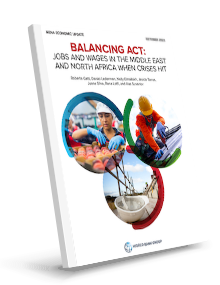Algeria | Bahrain | Djibouti | Egypt | Iran | Iraq | Jordan | Kuwait | Lebanon | Libya | Morocco | Oman | Palestinian Territories | Qatar | Saudi Arabia | Syria | Tunisia | United Arab Emirates | Yemen
Country Profiles
Chapters
Part I | Macroeconomic Outlook
2023 is likely to be another year with a changing global environment that is yet again depressing growth expectations. World Bank economists forecast that growth in the Middle East and North Africa (MENA) will sharply decelerate to 1.9% in 2023 after growing 6% in 2022 when Gulf Cooperation Country (GCC) economies benefited from a surge in oil prices. While oil exporting economies will decelerate the most in 2023, especially among the GCC countries, indebted oil importers continue to grapple with the effects of the tightening of global financial conditions. The region’s GDP per capita growth is expected to plummet to 0.4% from 4.3% in 2022. While inflation is subsiding among GCC economies and developing oil exporters, exchange rate depreciations continue to feed inflationary pressures among developing oil importers. In fact, the shocks to commodity prices from the effects of the COVID-19 shock and Russia’s invasion of Ukraine have resulted in an all-time high volatility in the terms of trade of the MENA region.
Part II | The Balancing Act
This edition of the MENA Economic Update, a semiannual publication, examines the human side of macroeconomic turmoil. It sheds light on the delicate balance economies must strike when facing negative economic shocks that reduce labor demand. The report documents that during economic downturns the region’s increase in unemployment is nearly double that of other emerging markets and developing economies. The authors estimate that the macroeconomic shocks of 2020-22 led to an additional 5.1 million individuals becoming unemployed in MENA above the already high rates experienced by MENA countries even before Covid struck. Importantly, these transitory macroeconomic shocks can have long-lasting impacts on the region’s workforce, which can be reflected in higher long-term unemployment and informality rates following involuntary job displacements. Another mechanism of labor market adjustment highlighted in the report is the reduction in real incomes in contexts of high inflation. While unemployment spells can permanently scar the region’s workforce, the erosion of real income can have dire implications in terms of living standards and existing inequality. The authors underscore that neither outcome is desirable, discuss policy options, and advocate for maintaining flexible real wages during periods of adverse economic shocks while simultaneously protecting the most vulnerable through well-targeted cash transfers.





